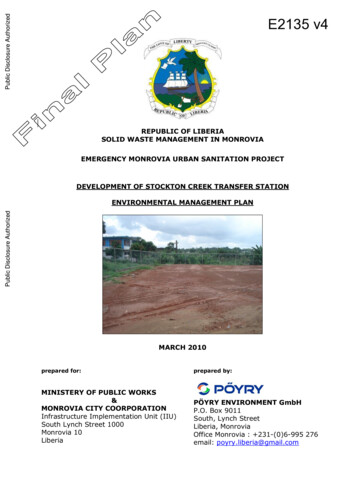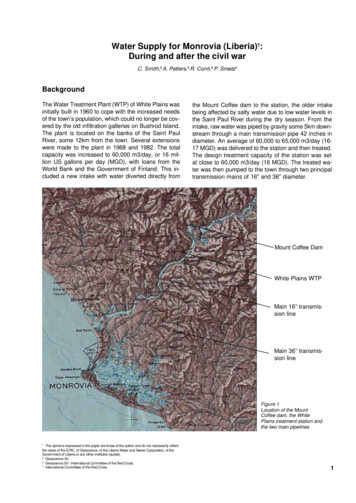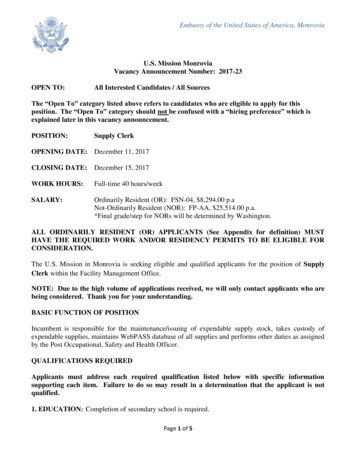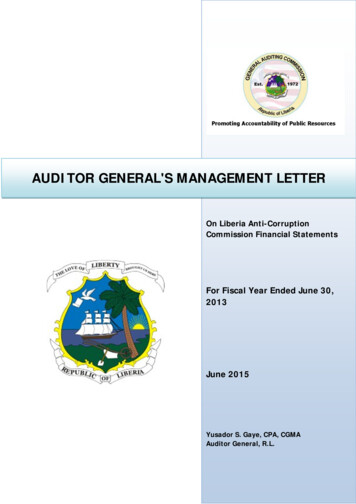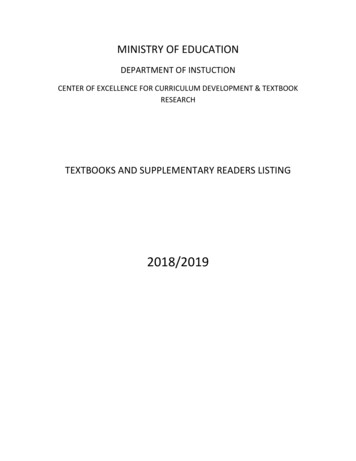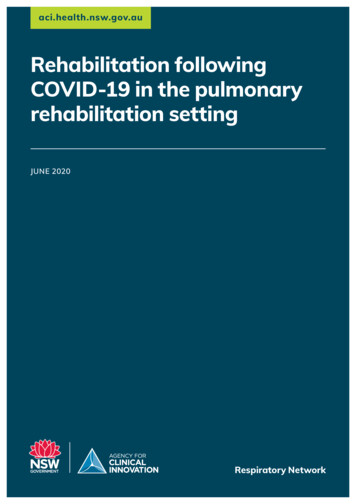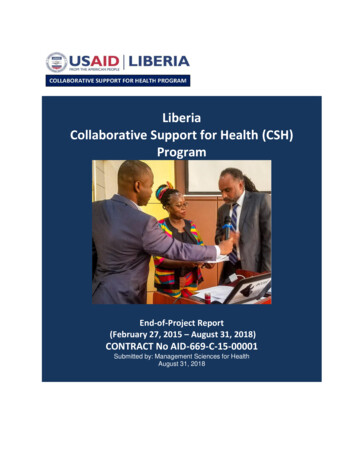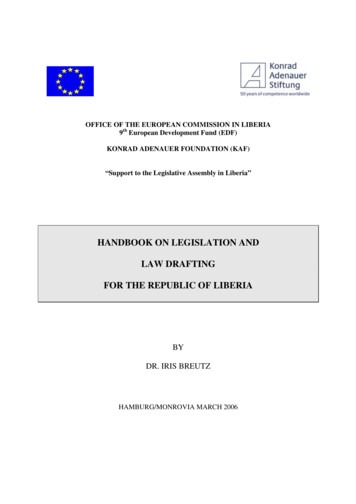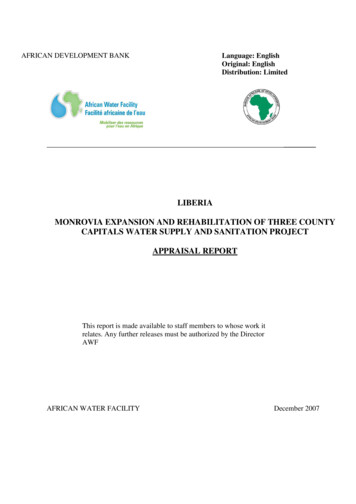
Transcription
AFRICAN DEVELOPMENT BANKLanguage: EnglishOriginal: EnglishDistribution: LimitedLIBERIAMONROVIA EXPANSION AND REHABILITATION OF THREE COUNTYCAPITALS WATER SUPPLY AND SANITATION PROJECTAPPRAISAL REPORTThis report is made available to staff members to whose work itrelates. Any further releases must be authorized by the DirectorAWFAFRICAN WATER FACILITYDecember 2007
iCONTENTSEXECUTIVE SUMMARY . 11BACKGROUND .31.11.21.31.42THE PROJECT .112.12.22.32.42.52.62.72.83PROJECT RATIONALE AND ORIGIN .3SECTOR PRIORITIES .4PROBLEM DEFINITION .5BENEFICIARIES AND STAKEHOLDERS .9PURPOSE .11IMPACTS.11OUTCOMES .11OUTPUTS .12ACTIVITIES.12RISKS AND ASSUMPTIONS .13COSTS AND FINANCING .13JUSTIFICATION OF AWF FINANCING .14PROJECT IMPLEMENTATION.143.13.23.33.43.53.63.7THE RECIPIENT/EXECUTING AGENCY .14IMPLEMENTATION ARRANGEMENTS .14IMPLEMENTATION SCHEDULE .15PROCUREMENT .16DISBURSEMENT ARRANGEMENTS AND EXPENDITURE SCHEDULE .16ACCOUNTING AND AUDIT ARRANGEMENTS .17MONITORING EVALUATION AND REPORTING ARRANGEMENT .174EFFECTIVENESS, EFFICIENCY AND SUSTAINABILITY.175CONCLUSIONS AND RECOMMENDATION.185.15.2CONCLUSIONS .18RECOMMENDATION.18
iiCURRENCYCurrency Used1 EUR::United States of America Dollar (USD)USD 1.36LIST OF ABBREVIATIONS AND UNDPUNICEFUSAIDUSDWATSANAfrican Development Bank (Fund)African Water FacilityDepartment for International DevelopmentEuropean CommissionGovernment of LiberiaKreditanstalt fur WiederaufbuLiberia Water and Sewerage CorporationMinistry of Land, Mines and EnergyProject Preparation FacilityRural Water Supply and Sanitation ProgramUnit of AccountUnited KingdomUnited Nations Development ProgramUnited Nations Children’s FundUnited States Agency for International DevelopmentUnited States DollarWater Supply and SanitationLIST OF ANNEXESAnnex 1: Map of Liberia with Location of Study AreasAnnex 2: LWSC and Project Management Organization ChartAnnex 3: Implementation ScheduleAnnex 4: Detailed Estimated CostsAnnex 5: Terms of Reference
iLogical FrameworkHIERARCHY of OBJECTIVES,EXPECTED RESULTSREACHBENEFICIARIESGOAL :To increase accessibility to safedrinking water supply and basicsanitation facilitiesIMPACT: Improved water and sanitation services Increased productivity of population in the four towns The populationof the four towns Water serviceprovidersOBJECTIVES:OUTCOMES: Adequate resources mobilized based on the reports,designs and documents validated by the Government ofLiberia, for reliable and affordable WSS services to theMonrovia and 3 county towns population. The population atlarge Water serviceproviders Water relatedinstitutions in thecountry WaterprofessionalsTo prepare economically andtechnically sound priority projectfor the Monrovia and threetowns and mobilize adequateresources for implementation.ACTIVITIESOUTPUTS Assessment of the existingconditions in the project areasConduct feasibility studyConduct geotechnicalinvestigationsConduct water quality studiesUndertake detail design, tenderdocuments and cost estimatesOrganize 3 workshops and aResource MobilizationConferenceFeasibility reportDetail design and engineering reportTender documents and cost estimatesFinancing planWorkshop reportsResources Mobilization Conference report on amountspledged by donors Consultants L:WSC Staff Other DICITYIndicators: %ofpopulation servedwith WSS servicesSource: Baselinedata collected underthe study andGovernmentstatistical bulletinsand economicreports.Indicators: % ofresourcesmobilized/resourcesrequirementsSource: Donorsmeeting report andamounts pledged.Progress reports.Periodicity:Quarterly & AnnualreviewIndicators: Approval ofgrant Engagement ofConsultants ; Geotechnicalinvestigations Water qualitymonitoringSource: ProjectreportsPeriodicity:quarterlyINDICATIVE TARGETSand TIMEFRAME- Coverage of safe water fromcurrent 22% and basicsanitation from current 15%increased to 45% by year2010 and to 100% by year2025.Achieving the National MDGtarget for 2010RISKS , MITIGATIONMEASURES Continued governmentsupport and priority forWSS sector.Commitment of allstakeholders to theproject objectivesAll feasibility , design andtender document prepared bythe end of February 2009Consultant may not deliverygood quality reports on timeCloser supervision by PIUGrant approval Jan 08Consultant mobilization –June 08-Geotechnical investigation –Sept -07WQ monitoring-July-Oct 08Government provides itsfinancial , human resourcesand logistical requirements in atimely manner
1EXECUTIVE SUMMARY1.The purpose of the Water Supply and Sanitation for Monrovia and the three county capitalsProject is to a) study economically, technically, environmentally and socially viable watersupply and sanitation systems to meet 2025 demands in Monrovia and three county capitals ofKakata, Zwedru and Buchanan, where the Liberia Water and Sewerage Corporation isresponsible for services production, and b) develop water sources, abstraction, waterconveyance and transmission, water treatment facilities, water distribution network, andsanitation facilities in Metropolitan Monrovia, Kakata, Zwedru and Buchanan as well asefficient water metering and billing systems utilizing appropriate, affordable and least costtechnology, and c) mobilize adequate resources for LWSC to implement the expansion andrehabilitation of the WSS systems.2.The project is to undertake three stage studies consisting of: Stage 1: Feasibility study; Stage2: Detailed designs for the study area WSS systems, engineering and preparation of tenderdocuments; and Stage 3: Resource Mobilization.3.The project will contribute towards alleviation of poverty in the study areas through theprovision of clean and affordable and sustainable water and sanitation services and alsosupports in promoting more efficient use of available WSS services. The project is consistentwith the country’s MDGs Action Plan for water and sanitation, the Interim Poverty ReductionStrategy (IPRS) and in line with the Government policy of rehabilitating infrastructure andutilities for urban dwellers in Liberia on priority basis. Monrovia, Kakata, Zwedru andBuchanan have been selected for the study, because their WSS infrastructure needs urgentrehabilitation, replacements and extensions, since during the civil war infrastructure has notbeen properly maintained, and in addition, suffered severe damages.4.The outcomes of the project will consist of adequate resources mobilized based on proposalsand designs for water supply and sanitation facilities, which will, when implemented, providereliable services for the people in Monrovia (1,500,000 people) , Kakata (25,000 people),Zwedru (10,000 people) and Buchanan (35,000 people). This in turn will have a multipliereffect on health and productivity of the people, and will subsequently support povertyreduction efforts on the national level.5.The project outputs include but not limited to the following: Feasibility study comprising of a thorough evaluation of alternative schemes for thevarious units and operations of the proposed investment project. Detailed designs for the study area WSS systems and tender documents withengineering analysis ,designs , construction drawings, specifications ; bills ofquantities, conditions of tender and contract documents along with detailed costestimates; and Donors’ meeting for mobilizing resources for the investment project. The donors’meeting will be organized after finalization of the study in order to solicit funding forthe proposed investment project.
26.The estimated cost of the project, net of taxes and duties, is Euro 1.6 million, of which Euro 1.216million is in foreign exchange and the remaining 0.384 million is in local cost. The costs arebased on recent studies in Liberia and other countries in the region. A provision of about 8% ofthe study’s base cost has been considered to cover physical contingency. AWF will finance 95 %of the project while remaining 5 % will be a Government’s in kind contribution in the form ofoffice accommodation.7.In order to successfully implement the project, the Steering Committee which has already beenconstituted for the Monrovia Water Supply and Sanitation Immediate Rehabilitation Programwill also guide this proposed study. The Steering Committee is chaired by the Minister of PublicWorks or his representative and consists of representatives of the Ministers of Lands, Mines andEnergy, Finance, Managing Director of LWSC, Member of Engineering Society, a local NGO, arepresentative from the private sector and is hosted by the LWSC/PT, serving as a secretariat.The role of the Committee is to monitor, and provide policy and general managerial guidance andadvocacy during the project execution. The Committee will sit every quarter to reviewimplementation plans, project progress and any problems encountered, in order to offer adviceand suggestions to enhance smooth implementation of the project.8.The LWSC as the Executing Agency will be responsible for project implementation. The ProjectTeam (PT) set up for Monrovia Water Supply and Sanitation Immediate Rehabilitation Projectwill also be responsible for the study. The PT comprises of the Deputy Managing Director forTechnical Services of LWSC, the Study Manager assisted by Technical Services Manager andChief Accountant. The PT will be responsible to coordinate all the day-to-day business of theproject monitoring and management.9.The total implementation period of the project will be 16 months after Grant approval. TheConsultant shall complete all work within a maximum period of 11 months from the receipt ofnotice to proceed including mobilization period and the time required for review and approvalof the submissions.10.Procurement arrangement for the project will be through shortlist at international level. LWSCshall prepare a shortlist of qualified and experienced consultancy firms. The recruitmentprocess including the shortlist of the consultants and evaluation of proposals will be theresponsibility of LWSC, which shall forward the shortlist, the required documents, and theresults of the evaluation to the Bank for approval. The following documents will be preparedby LWSC for approval by the Bank: Shortlist of consultancy firms; Request For Proposals (RFPs) to the consultants; Proposals evaluation reports; and Contract negotiations and draft contract agreements.12.It is recommended that a grant not exceeding EUR 1.52 million from the African Water Facilityresources be extended to Liberia in order to carry out the study.13.The opening of a Special Account in a Commercial Bank acceptable to the Bank and thenomination of a Project Coordinator acceptable to the Bank are the conditions for firstdisbursement.
311.1BACKGROUNDProject Rationale and Origin1.1.1 Liberia is a West African Country located between longitude 7030' and 11030' west andlatitude 4018’ and 8030' north. It covers a total surface area of about 111,370 sq. km (about 43,506square miles). The dry land extent is 96,160 sq. km. The surface water area is 15,050 sq. km. Itborders Sierra Leone to the northwest, Guinea to the north, Cote d’Ivoire to the northeast and east,and the Atlantic Ocean to the south and southwest. Its north-south extent is about 465 km and itsAtlantic Ocean coastline is about 520 km long. The terrain comprises mostly of flat to rolling coastalplains, rising to rolling plateau and low mountains in the northeast. The coastline is characterized bylagoons, mangrove swamps, and river-deposited sandbars. The country can be divided according toelevation into four main physical regions parallel to the coast: (i) coastal plains up to 100 m; ii) hillsfrom 100 to 300 m; iii) plateaus from 300 to 600 m; and iv) mountainous areas above 600 m. Thecultivated area was estimated at 600,000 ha (in 2002), of which arable land covers 380,000 ha, while220,000 ha are covered by permanent crops.1.1.2 Liberia’s climate is tropical hot-humid. Winters are dry with hot days and cool to cold nights;summers are wet and cloudy with frequent heavy showers. The rainy season lasts from April toNovember and average annual rainfall is estimated at 2,391 mm, with a spatial variation from 2,000 to5,000 mm. Although this is much higher than the quantity of water required for crop growth, an acutewater deficit is experienced during a 3 to 5 month period, particularly in the uplands.1.1.3 Liberia is presently divided into fifteen (15) major political subdivisions called Counties. Thecounties with their capitals are: Bomi (Tubmanburg), Margibi( Kakata), Maryland (Harper),Montserrado (Bensonville), Sinoe ( Greenville) Nimba ( Sanniquellie), Grand Gedeh ( Zwedru),Grand Bassa (Buchanaan), Grand CapeMount (Robertsport), Lofa (Voinjama),Bong (Gbarnga),Gbarpolu (Bopolu), Grand kru (Barclayville), River Cess (Cestos), River Gee (Fishtown). Each ofthese subdivisions is headed by a superintendent who serves as the vice juror to the President ofLiberia. Each superintendent is assisted by an assistant superintendent concerned with thedevelopment aspect of the political subdivision. There are sixteen (16) major ethnic groups or tribes inLiberia.1.1.4 Total population in 2004 was estimated to be about 3.5 million, of which 52 percent were ruralinhabitants and 48 percent living in urban, per-urban and small towns’ environment. Urban areasconstitute densely populated non-agricultural based economy with population in excess of 5000; mosttowns are county capitals serving both as political, commercial and business centres. The populationdistribution pattern in the country is highly uneven, Montserrado county accounts for over 25% of thepopulation, Nimba 15%, Baong and Lofa 12%. The national average population density was 78inhabitants per square mile in 2002. Counties which exceeded the national population density areMontserrado, Baong and Nimba.1.1.5 Before the Liberian Civil Crisis, 35% of Liberians had access to safe drinking water supplyand 27% to adequate sanitation. Today, it is estimated that only 17% has access to safe drinking waterand 7% to adequate sanitation. The capital of the country, Monrovia, had 700,000 inhabitants, whichreceived 18 million gallons a day of pipe borne water supply. Today, the city has 1.5 millioninhabitants, but only 1.4 million gallons of pipe borne water supply.
41.1.6 Liberia had GDP per capita of income of USD 191.5 or GDP of USD 380.9 million in 2005. Itis one of the poorest countries in the world. More than 80% of the people live below the poverty line,less than one USD per person per day. Liberia also faces the chronic problem of unemployment thatreaches 85% at the present time. There is a growing body of evidence that suggests that Childmortality rate is about 194 for males and 198 for females per 1000 live births. Life expectancy at birthis 47.7 years and the crude adult mortality rate is 590 for males and 484 for females per 1000. AdultLiteracy rate is 50% for men and only 26% for women. Net elementary school enrolment is 34.7 %.The national health statistics indicated that the access to health services is 69.4%, and the prevalenceof HIV/AIDS is 10-12%.1.1.7 Waterborne diseases, including malaria and worms, are most common among people becauseof the use of unsafe water sources and inadequate domestic and public sanitation facilities. Thesanitation condition is very poor throughout the country, as pit latrines and bush/river serve as themain toilet types, imposing health problems especially where densities of population are high. Theproblem is further compounded with the looting and destruction of public infrastructure during theprolonged civil war that resulted in massive internal displacement and migration of population. Thishas been particularly severe in urban settlements like Monrovia, Kakata, Zwedru and Buchanan,where the WSS infrastructures is rendered useless.1.1.8 The Government of Liberia is committed to address the deteriorating situation of water supplyand sanitation facilities all over the country, particularly in urban areas and small towns, where theproblems are chronic and pronounced.1.1.9 Following the GOL request for AWF support for conducting water supply and sanitation studythrough a letter dated 30 October 2006. The Bank’s appraisal mission was undertaken from June 22July 6, 2007. This report is a result of the mission.1.2Sector Priorities1.2.1 The Liberian Government is committed to address the huge tasks facing the water sector onpriority basis, but has very limited resources available for water budget. Water sector institutions arenot sufficiently organized at the national and county levels. Only the LWSC provides rudimentaryservices, even this responsibility is limited to Monrovia. The LWSC has very limited capacity, interms of qualified manpower, resources, facilities and services, to carry out its present responsibilityof providing WSS service. At present manpower numbering 171, most of them are techniciansengaged in operational activities and general service works. There are only 15 professionals includingtwo qualified engineers and one hydro-geologist, 4 economists, and 8 accountants.1.2.2 During the war, the water and sanitation facilities were substantially damaged and are now insever state of disrepair. At present, Metro Monrovia, which has approximately 1.5 million inhabitants,including the internally displaced, receives only 7,500 m3/day (2 million US gallon/day). Themajority of the population in Liberia, mostly clustered in urban and peri-urban surroundings haveaccess to water from unprotected water wells, streams or springs. Sanitation is limited todamaged/failed latrines (household, neighborhood, public and open defecation in most cases). InMonrovia the dilapidated water and sewerage works are almost out of use except for few connectionsin the central district. As a result of the accumulated problems WSS development is accorded a highpriority in the Country Interim Poverty reduction strategy (IPRS).
51.2.3 As a post- conflict country with devastated water infrastructure across the nation, and morepronounced in the urban areas and small towns, the chronic and acute shortage of WSS facilities hasresulted in a sporadic outbreak of water related diseases like cholera, culminating in high level ofmorbidity and heavy burden on health facilities. As such the government gives high priority to therehabilitation of WSS facilities in the immediate future.1.3Problem definition1.3.1General1.3.1.1 Before the civil war, about 45% of the urban population had access to drinking water fromimproved sources, compared to 23% in the rural population. Eleven urban cities were served withpiped water. As a result of civil hostilities, the piped supply of water to urban centers have almostceased during the years of strife. Unauthorized use of water including theft and leakage was very highas well as the number of illegal connections on the remaining network. In reality, much of thedrinking water is delivered by truck to either centralized points of distribution or individual storagetanks. Only small parts of Monrovia currently have piped water supply. The other county centers andsmall district towns are dependant on neighborhood and family owned hand-dug wells, provided byNGOs like Oxfam, Tear Fund, Concern, ICRC and ESAs like UNDP and UNICEF. Except forMonrovia, most of the towns were not served with conventional sewerage system.1.3.1.2 Poor Water Service and High Unaccounted-For-Water (UFW): Water supply services arecharacterized by interruptions and wide fluctuations due to breakdowns and due to long time periodsbefore corrective maintenance and repairs are carried out. The situation is exacerbated by high UFW,amounting to 65-75% of the water production in most of the areas particularly in Monrovia. 80% ofthe UFW is attributed to leakage and 20% to illegal connections. The high UFW represents a seriousconstraint on effective service delivery, undermining the limited financial capability of the waterutility.1.3.1.3 Lack of Enabling Environment: Policies and strategies provide the definitive environment inwhich sustainable development takes place. The absence of policies and strategies in Liberia resultedin stunted and non-sustainable services with minimal benefits. In this transitional stage, activities arefocused on implementation of individual projects without the robust enabling environment andplanning instruments. The existing institution lack clearly established duties and responsibilities. Inaddition, there are no coherent coordination mechanisms among different stakeholders; fragmentationand duplication of efforts are common, leading to ambiguities in responsibilities among differententities. There is no water resources ministry and the MLME is now entrusted with water sectorregulation. However, the MLME doesn’t have fully operational water department, a situation whichnegatively affects on water resources planning and development. Moreover, LWSC has very littlecapacity for planning and development and is primarily working as a utility operator, though it hasmandates for Water and Sanitation development. In addition, the Authority of Rural Development isbeing phased out from rural water and sanitation sector, while there is no custodian to take over itsresponsibilities. The MLME is taking a lead initiative to undertake Water Sector Reform studiesincorporating policy, strategy, institutional reforms, capacity building, and investment planning. Thisinitiative has been discussed with the development partners including the ADB, the World Bank, EUand DFID; they have all expressed their willingness to support and complement the initiative, and theMLME requested the AWF to finance it.
61.3.1.4 Human Resources Constraint: The human resources capacity in all organizations, at present,consists of skeletal staffing assigned during the transitional Government mandate. In addition waterinstitutions are poorly resourced. While the situation demands the participation of more engineers andother skilled staff to carry out the reconstruction efforts, the current low salary scale does not attractcapable professionals.1.3.1.5 Low Financial Performance: The current Government budget is very limited amounting toabout US 200,000 per annum for LWSC. On the other hand high level of arrears has been a chronicproblem for a long period of time. This situation is compounded with inadequate tariff and billing anda collection structure with low revenue amounting to 30% of water bills. Under these circumstances,it has been very difficult to operate the systems efficiently and that the weak financial position ofLWSC has been aggravated.1.3.1.6 Monitoring and Evaluation Mechanisms: There is a lack of Monitoring and Evaluation(M&E) mechanism. The Government has also recognized the impact of this shortcoming on sectordevelopment and there is a need to develop M&E mechanism on priority basis to be installed in theshortest possible time. This requires work on developing indicators for M&E as well as on the processof information generation, transmission, collection, analysis, storage and dissemination. The Bankthrough its quarterly supervision missions will support the MLME to put in place M&E mechanismsand practices for the project.1.3.1.7 Coordination of Donor Interventions: Apart from Donors’ own procedures and process forapproval, disbursement and procurement, there is a need to set up a mechanism for coordination. Thesituation is exacerbated by the low Government capacity of implementation, and lack of coordinationto utilize common implementation instruments. This is visibly affecting the progress in the muchneeded rehabilitation of water and sanitation systems in both rural and urban areas. The Bank throughits quarterly supervision missions will coordinate with other donors and support the Government totake the lead.1.3.1.8 Community Participation: At present, there are no well considered plans to engage incommunity mobilization and promotion efforts aimed at gaining support to current initiatives as wellas for dissemination of information. This is especially important for sanitation, which is mostly ahousehold responsibility. Dialogue with the population on design of affordable latrines, maintenanceand use is necessary for safeguarding the people's health.1.3.21.3.2.1Existing Situation and WATSAN Problems in the Study areasMonrovia1.3.2.1.1Metropolitan Monrovia covers 43.2 km, 2constituting 0.07% of the country’s total area.Central Monrovia is made up of 9 districts and its environs are made up of 7 districts. The terraincomprises mostly of flat to rolling coastal plains, rising to rolling plateau. The coastline ischaracterized by lagoons, mangrove swamps, and river-deposited sandbars. Main problems associatedwith the aquatic environment, are soil erosion, loss of biodiversity, and pollution of coastal waters
7from oil residue and raw sewage. Water-borne diseases such as diarrhea, dysentery, cholera andinfectious hepatitis are common.1.3.2.1.2The Metropolitan Monrovia has a present population of about 1.5 million people; withpopulation density of 34,700 persons/km2. Monrovia is the administrative and economy capital ofLiberia, and Public institutions, commerce and informal sector businesses are the mainstay of theeconomy in the city. In 1990, Monrovia had 700,000 inhabitants, which received 60,566 m3/day (16million gallons/day).1.3.2.1.3The water service is based on a surface water source system abstracting water from thenearby St Paul’s river and undergoing conventional treatment through sedimentation, filtration, andchlorination. After treatment, water is pumped to storage reservoirs, transported by the transmissionmain, and subsequently distributed to the population through Public stand posts and householdconnections. Prior to the civil conflict, the average daily water production for the city of Monroviaamounted to 67,651 m3/day (18 MGD). Today, the city has only 9,843 m3/day (2.6 milliongallons/day), with frequent interruptions.1.3.2.1.4Currently, the Monrovia Water Treatment Plant is functioning 8 hours a day, for about5 days per week, providing 2 MGD. When Supply from the WTP is interrupted, water supply toMonrovia is augmented through the use of two (2) borehole fitted with submersible pumps. The watertreatment plant has a design capacity of 16 million gallons per day with a hydraulic capacity of 24million gallons per day. At present it is capable of producing only 2MGD and with frequentinterruption There are two clear well reservoirs, one is 1 million gallons and the other is 0.5 milliongallons.1.3.2.1.5There are two main transmission pipe lines (16” and 36”), which are in fairly goodcondition. The 16” is in operation and the 36” has been tested twice. However, some of the Air ReliefValves, Blowout Valves and Air Gauges need to be replaced or repaired. The distribution network inMonrovia comprises of cast iron, PVC, ductile iron, asbestos cement, and galvanized pipes. Atpresent most of these pipes are out of order especially the galvanized pipes. Due to erosion, most ofthe pipes are exposed on the surface, which poses danger of uplifting if pressure is increased.1.3.2.1.6The existing water borne sewerage system was planned to cover 17% of Monroviaserving major portions of the city down town including Bushrod Island and Sinkor areas. The systemcomprises 61 Kms of sewers and force mains and 4 pumping stations. The network is connected to awaste stabilization pond, which discharges to the ocean through concrete outfalls. The sewage systemcovered with overgrowth of weeds and huge accumulation of sludge over the years. As a result, thesewerage network is out of service and the effective capacity of the sewage stabilization ponds hasseverely been reduced. Similarly, the lagoon covered with overgrowth of weeds and hugeaccumulation of massive sludge. The outfalls are damaged.1.3.2.2 The three Towns of Kakata, Zwedru and Buchanan1.3.2.2.1The three towns have water supply systems based on groundwater abstraction thatwere installed in the late seventies and early eighties. At the present time none of them are providingservice from the centralized source; all these system
MONROVIA EXPANSION AND REHABILITATION OF THREE COUNTY CAPITALS WATER SUPPLY AND SANITATION PROJECT APPRAISAL REPORT This report is made available to staff members to whose work it relates. Any further releases must be authorized by the Director AWF AFRICAN WATER FACILITY December 2007
